- What is an Air Conditioner?
- Main components of Air Conditioner
- How Does an Air Conditioner Work?
- Different Types of AC
- Concept of Inverter AC
- Inverter AC Vs. Non-Inverter AC
- Concept of Energy Star Rating (EER, ISEER)
- Air Conditioner Refrigerants
- Air Conditioner Compressor and its Types
- Types of Condenser Coils used in Air Conditioners
- Other Features
- Smart Features
- Tips for Care and Maintenance of the Air Conditioners
- Frequently Asked Questions(FAQs)
- Conclusion
Choosing the right AC for your home and office is a difficult task. Therefore, we came up with this blog covering the detailed AC buying guide, so you always go for the best one.
Some air conditioners are energy efficient, some are highly performing, some offer better cooling over others, and even some come with all the features. So, which one to choose is quite difficult. It needs lots of consideration to buy the most ideal one. But you often get confused as there are a lot of brands and models with variable features and functionalities.
To choose the right one for your home or office, it is very much essential to know about every single detail on air conditioners. Below is the complete AC Buying Guide which will give you in-depth information on the Air Conditioner.
What is an Air Conditioner?
An air conditioner is an appliance that cools down the room or the place where you have installed it by removing the heat from the same place and then move it out to the outer area. It actually controls the temperature of the room and thus maximizes comfort in the extreme hot and humid conditions.
Nowadays, many air conditioner brands also come with the models that not only cools out the living area but also heats it up. These are generally known as Hot And Cold AC. Thus, these types of air conditioners are ideal for the winter season too. Plus, they come with a thermostat that ensures to heat your room at the optimum comfortable temperature.
Air conditioners are also termed as “split-systems” because their working mechanism involves two units, one for indoor and the other for outdoor. These two units work together to cool down an interior space. To understand the working mechanism of AC, read the below sections.
Main components of Air Conditioner
The Air Conditioner uses five basic components to work. These components include:
- Evaporator
- Compressor
- Condenser
- Expansion valve
- Refrigerant
How Does an Air Conditioner Work?
Here is the full description on how an air conditioner works using the above components.
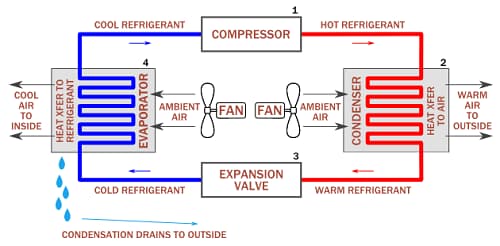
The Air conditioner draws out the inner heat and then transfers it out to the outside air. This way, it cools the inner air.
After you switch on your AC and set out your desired temperature, the thermostat comes with the AC senses that there is a difference between the room temperature and the temperature that you have chosen.
For its working, it mainly uses the three components that include an evaporator, compressor, and condenser. The evaporator is fixed in the inside unit, and the compressor and the condenser are located at the outside unit of the air conditioning system. Then the cooling process is done in the following steps.
Step 1: The Evaporator that is a heat exchanger coil, collects the inside heat through the refrigerant gas. Then the liquid refrigerant absorbs that heat from the passing air to evaporate it into the gas from liquid. And then it goes through the compressor.
Step 2: In this step, the working of the compressor takes place. The compressor that is present at the outside unit reduces the gas volume to raise the pressure and the temperature of the refrigerant. And then preparing it for the condensation process that will be done using the condenser.
Step 3: The vaporized refrigerant now reaches the condenser and then expels the heat outside. Then the outside air absorbs that heat from the refrigerant and lowers down the temperature of the refrigerant. This process converts it again into a liquid.
Step 4: Here comes the role of expansion valve that is placed between the two sets of coils, including chilled coils of the evaporator and hot coils of the condenser. The liquid flows through the expansion valve that controls the flow of cool liquid refrigerant into the evaporator.
Step 5: The cold refrigerant then goes back to the indoor unit through the evaporator to follow the same procedure again. The process continues until your room temperature reaches your desired level.
Different Types of AC
1. Window AC
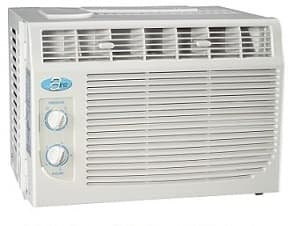
Like the name, the window air conditioners need to get installed on the window of your room. It comes with only one unit that combines the compressor and blower in it. The blower portion comes at the front-facing your room while the compressor comes to the opposite of it facing the outer area. Thus, it cools the room by emitting hot air out the back of it and blowing cold air into it.
Pros
- Cheaper over the split types
- Easy to install
- Shifting and reallocating is very easy
- Good for small rooms and spaces
Cons
- Noisy operation
- Not ideal for large room
- Blocks the window where it is installed
2. Split AC
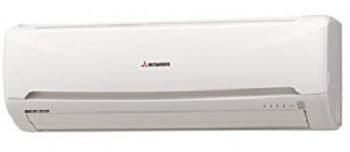
The split air conditioners are becoming very popular nowadays because of more benefits as compared to Window AC. Like the name, split ACs include two units- indoor and outdoor. The indoor unit is wall-mountable, and the outdoor unit is placed outside of the room either on the rooftop or balcony, etc.
The indoor unit comes with the blower, and the outdoor unit includes a compressor and the condenser. The compressor is connected with the blower along with the connection of the pipe that goes through the wall. The working mechanism includes that the compressor collects the hot air from outside and makes it cool. Then this cool air passes through the blower. The blower, in turn, blows out the cool air inside the room to make it chill and cold.
Pros
- Aesthetically appealing
- Easy to install at the room wall
- A great option for your bedroom because of low noise operation
- Suitable for large rooms too
Cons
- Expensive over the window AC
- Shifting and reallocating is quite difficult
3. Central AC
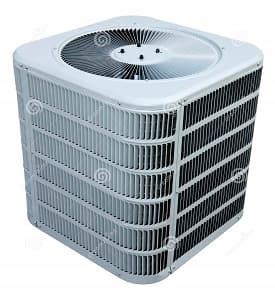
These are one of the luxurious air conditioning systems that are capable of cooling each room of your home very efficiently. It comes with two separate units. The outdoor unit combines condenser coil, compressor, and a fan. The indoor unit comes with the evaporator coil that needs to get installed on top of the gas furnace inside the home.
Both the indoor and outdoor units are connected with each other via the refrigerant tubing. The Central air conditioners circulate the cool air through supply and return ducts. For this, the condensing unit generates the cool air that is pushed into the evaporative unit. The evaporative unit then pushes out the cool air throughout your home using the furnace duct system. It also includes a thermostatic control that lets you set your desired temperature.
Pros
- It keeps cool the whole home, office area, hospitals, etc.
- Very quiet operation
- More efficient over the window and split ACs
- Offers clean air using the filtration system
Cons
- Installing requires a lot of planning
- You must need sufficient space for proper installation
- Quite expensive
4. Portable Air Conditioner
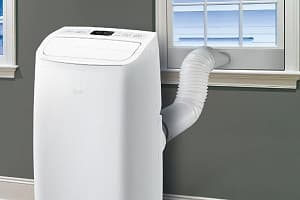
Like the name, these are portable units that you can easily move from one room to another. You can place it on the floor near the window like air coolers. The unit comes with a plastic hose that you need to attach its one end to the AC and the other end outside the window. Thus proving to be a great cooling solution anywhere in your home.
Pros
- Requires easy installation
- Easy to move from one room to another, one apartment to another
Cons
- Noisy
- Expensive
Concept of Inverter AC (What is Inverter AC?)
Most people have the misconception that an Inverter AC is that which works on a home inverter. But it is absolutely a wrong conception. Like you know, in the regular air conditioners, their compressor works at full speed when the AC is on. And when it reaches the optimum temperature, the compressor gets off, but the fan still works. Thus, it consumes a lot of electricity.
But, the air conditioners with inverter technology adjust the compressor speed and thus ensures fast and consistent cooling. In this case, the compressor runs continuously at variable speeds. And so, it consumes only that much power which is required to keep the temperature stable at the desired level. Thus, we can say that it can automatically adjust its capacity on the basis of the requirement to cool the room.
This way, the Inverter ACs consumes very less power and are more energy-efficient as compared to the regular air conditioners. Most of the top-most brands like LG, Samsung, Voltas, And Hitachi, etc. comes with a wide range of Inverter ACs.
Inverter AC Vs. Non-Inverter AC
- Inverter ACs run at the variable speed while non-inverter ACs run at a constant speed.
- Inverter ACs are more energy-efficient as compared to non-inverter ACs.
- The inverter ACs are more quiet in operation over the non-inverter AC.
- It cools out the room faster than the non-inverter ACs.
- Inverter ACs come with longer life span as compared to the non-inverter models.
Concept of Energy Star Rating (EER, ISEER)
Most of the latest electrical appliances like refrigerators and air conditioners, etc., come with a label of star rating. But do you know what this star rating signifies?
This star rating determines how much electricity the appliance will consume once you have bought it. Now the question comes who decides this energy star rating?
BEE (Bureau of Energy Efficiency) sets the standards for marking the star-rating on various electrical appliances. You will find these star ratings in the form of labels on an electrical appliance. The star rating is given out of five that lets you decide upon how energy efficient the appliance is?
The Star rating is compulsory for only the following heavy electrical appliances, including Air Conditioners, Refrigerators, Colour TV, and Electric Geyser, etc.
Now, let’s discuss the factors affecting the efficiency of the AC units. But before understanding the concept of EER and ISEER, let’s know about BTU.
BTU
BTU stands for British Thermal Unit. And Air conditioners are rated in BTU irrespective of their capacities and tonnage. The BTU number shows how fast an AC can cool a room, with a fixed outside temperature.
Mathematically, 1 Kw/hr= 3,412 BTU
The BTU number also determines the tonnage of AC.
1 ton = 12,000 BTU/hr
EER (Energy Efficiency Ratio)
EER = Amount of heat removed per hour / power consumed by the AC
Therefore, EER = BTU/hr/ Watt
The air conditioner removes more heat per hour per unit of power consumed. It shows that the higher the Energy Efficiency Ratio of AC, the better is its performance. In short, Air Conditioners with higher EER is better.
ISEER (Indian Seasonal Energy Efficiency Ratio)
The concepts of EER and ISEER are the same. The only difference is the seasonal element.
The ISEER = total amount of heat removed / total amount of energy consumed by the AC in active mode
It means, ISEER = Cooling Seasonal Total Load (CSTL) / Cooling Seasonal Energy Consumption (CSEC)
The ratio calculated is then used to choose the correct star ratings.
But note that these ratings are different for Windows and Split air conditioners. Also, these ratings change from year to year. Given below are BEE defined, ISEER ratings valid from 01 Jan 2018 to 31 Dec 2020.
ISEER Rating for Window AC
| Star Rating | Minimum ISEER | Maximum ISEER |
|---|---|---|
| 1 Star | 2.50 | 2.69 |
| 2 Star | 2.70 | 2.89 |
| 3 Star | 2.90 | 3.09 |
| 4 Star | 3.10 | 3.29 |
| 5 Star | 3.30 | - |
ISEER Rating for Split AC
| Star Rating | Minimum ISEER | Maximum ISEER |
|---|---|---|
| 1 Star | 3.10 | 3.29 |
| 2 Star | 3.30 | 3.49 |
| 3 Star | 3.50 | 3.99 |
| 4 Star | 4.00 | 4.49 |
| 5 Star | 4.50 | - |
Air Conditioner Refrigerants
The refrigerant is a very important component of an air conditioner that is responsible for providing cooling to your room. It is a compound that is found either in a liquid or gas state and is present in the condenser coils of the air conditioner.
It works by absorbing the heat of the indoor air and then ejects it out to the outside environment. Thus, the refrigerant present in the air conditioner ejects out the heat quickly and makes the room cool very fastly.
Some of the most common types of refrigerants used in air conditioners include:
HCFCs (Hydrochlorofluorocarbon), also known as R-22 that is a replacement for Chlorofluorocarbons (CFC), also known as R12 refrigerant. The R12 reduces the ozone content in the atmosphere that was the main reason for the replacement. The HCFCs are just better than CFC but not fully as it comes with chlorine that is again harmful to the environment.
HydroFluorocarbons (HFC) are also known as R- 410A, R-32, R134A. These are better than HCFCs or R-22 in many ways. It is environment-friendly and ensures no depletion of the ozone layer. The best part of this refrigerant is that it delivers maximum efficiency without any harmful effect on the environment.
Hydrocarbons (HC) are also known as R-290 or R-600A. These are the latest refrigerants that are most environment-friendly over the former ones. Also, these are entirely halogen-free and ensures no ozone depletion. And so, these refrigerants are very low in terms of global warming potential.
Air Conditioner Compressor and its Types
The compressor is the heart of the air conditioner. It plays a very significant role in cooling. Now the question comes how an AC Compressor works?
The compressor compresses the refrigerant gas to the high pressure when it enters the machine in order to increase its temperature. Thus, it converts the refrigerant into a high-pressure liquid at high temperature. This liquid then leaves the compressor and goes through the condenser coils so that the cooling process can begin.
Types of Air Conditioner Compressor
Now, when it comes to the type of air conditioner compressor, there are two major types:
1. Reciprocating Compressor
The reciprocating compressor is one of the most commonly used types of air conditioner compressors and is very versatile. It uses the piston and cylinder arrangements to compress the refrigerant that is more similar to the design of an engine automobile. The piston uses the back and forth motion with the power of motor and crankshaft that compresses the gas and then pushes it out to the condenser.
Pros
- Requires easy maintenance
- Very efficient and versatile
- It is able to produce both high power and high pressure
Cons
- Noisy
2. Rotary Compressor
A rotary compressor is the second most common type of air conditioner compressor that is quite small and reliable. It consists of a pair of rotors with a little space between each other and is attached to the cylindrical shaft. These rotors rotate in opposite directions in the cylinder and thus pushing the refrigerant through the cylinder. And this way, it gets compressed.
Pros
- Quiet operation
- Very safe and convenient
- It can work at high temperatures or in low conditions both
- Energy efficient
- Easy to maintain
Cons
- Expensive over the reciprocating compressor
Types of Condenser Coils used in Air Conditioners
The condenser coil is also an important component of the air conditioner. This condenser coil in the air conditioner is used to condense the refrigerant from gaseous to the liquid state by cooling it. It is also responsible to control the temperature.
There are two types of condenser coils used in the air conditioner- the copper coil and the aluminum coil. Now, if you think which one is best, let’s have a look at the below differences to decide upon the best one.
Copper Coil Condenser Vs Aluminum Coil Condenser
Heat Transfer
The copper coil has better heat transfer over the aluminum coil. And since the whole process of heat transfer in the air conditioner takes place through the condenser coil, the one with excellent heat transfer capacity will be ideal. In this respect, the copper coil proves to be better.
Cost
Copper coils are more expensive than aluminum coils. Thus, the air conditioners with copper coil condenser are highly-priced over the aluminum coil condenser.
Pliability
Aluminum has a better ability to be bent into desirable shapes as they are very flexible. On the other hand, the bending and molding of copper coils are harder. So, the manufacturing process and labor cost are quite less for molding the aluminum into the condenser coils. While to bend the copper into a condenser coil increases the labor cost, which in turn increases the manufacturing cost too.
Reliability and Repairing
The copper coils are easy to repair. But the aluminum coils are difficult to repair, that’s why it needs replacement.
Durability
The copper condenser is durable enough, and it can last for more than five years. On the other hand, the aluminum condenser is less durable over the copper condenser and can last for 2-3 years only.
Some Other Features to look for When Buying an AC for your Home and Office
1. Size of the Room and AC Capacity
With different cooling capacity and tonnage, the AC works differently for different sizes of the room. So, to decide upon buying the correct tonnage of AC, you must first calculate the size of the room where you want to install it.
On the other hand, the size or capacity of an AC is also an important aspect to consider before buying an AC. Oversized AC can increase electricity consumption while undersized AC affects the cooling capacity. .Here is the table to decide upon the right AC capacity as per the room size.
| Room Size | Tonnage required | BTU's Required |
|---|---|---|
| 100-120 Sq. Ft. | 0.5 Ton | 5,000 Btu |
| 120-150 Sq. Ft. | 0.75 Ton | 9,000 Btu |
| 150-180 Sq. Ft. | 1 Ton | 12,000 Btu |
| 180-250 Sq. Ft. | 1.5 Ton | 18,000 Btu |
| 250-300 Sq. Ft. | 1.8 Ton | 21,600 Btu |
| 300-350 Sq. Ft | 2 Ton | 24,000 Btu |
| 350-500 Sq. Ft | 3 Ton | 36,000 Btu |
2. AC Type
We have already discussed above the different types of air conditioner that you can choose according to the space available for installation. Window ACs are the cheaper variants and perfectly great for a small room. But you need to compromise a window for its installation.
Split ACs are now becoming very popular and can easily fit anywhere in your room. It also offers better cooling over the window AC.
But if you are the person living in a small area or frequently changing your living area, then you can go for the portable air conditioners too.
Many manufacturers are also selling Hot and Cold ACs too that not only cools your room but also heats it up during extreme cold conditions.
3. Energy Efficiency
Checking for the energy efficiency for any appliance is very important. It determines how much power the appliance will consume. The latest models of ACs come with an energy star rating determining the energy efficiency of that model. The energy rating ranges from 1 to 5 stars rated by the Bureau of Energy Efficiency (BEE).
It is recommended to go for the higher star ratings. Because the higher the star rating of the AC, the more it is energy efficient.
4. Inverter technology
Inverter ACs are very popular nowadays but are a little pricey too. In fact, it offers consistent and better cooling as well as good energy efficiency. So in comparison to non-inverter ACs, these consume one third less power, thus saves a huge on your electricity bills.
5. Air Quality and Filter Type
Air conditioners with a good filter type are very much important to improve the indoor air quality. A good quality filter in an AC effectively cleans out the air and also enhances the cooling performance and energy efficiency.
6. Noise control
A noisy AC spoils your sound sleep. So, to consider the noise factor is also very important before purchasing an AC. The ideal noise level for the operation of AC is within 50DB. So, check for it before buying an AC. You may find the noise level of operation of any AC in its product specification.
7. De-humidification
Almost all the air conditioners control the humidity while cooling. But there are some models too that come with separate de-humidification settings. These types of air conditioners are ideal for those places having high levels of humidity. Thus, the de-humidification setting in an AC reduces the humidity in the air and increases the level of cooling and comfort.
8. Installation, Cleaning, and Maintenance
To remain your AC in the best condition as well as for its great performance, it needs proper care and maintenance. Also, its performance relies on installation. So, make sure to install it from an authorized dealer only. When it gets installed, make sure it’s serving gets done every four months. These will ensure the optimum performance of your AC.
9. Price
AC is such a pricey investment. So, I am sure you would like to invest in a good one that will last for a minimum of 10 years. A reliable air conditioner comes with a starting price of Rs 30000 to a maximum of Rs 70,000. So, it’s up to you to decide the preferred price tag.
10. Warranty
Warranty and after-sales service on any product is a bonus to you. Most of the air conditioners come with at least one year warranty. But you must check the warranty on the compressor, condenser, and other components too. Because if any damage occurs to these components, you will have to pay a huge expense on them. So, make sure that these parts will cover good warranty and after-sales service.
Some More Smart Features to Consider
Sleep Mode: This feature offers you a comfortable sleep by setting the ideal temperature without waking up in the middle of the night.
Turbo Mode: This mode in AC offers faster cooling with energy-saving at the same time
Auto Start: This feature will automatically restart the AC by resuming the original temperature settings when the power is back. So, you don’t need to set it every time after the power cut.
Self-Cleaning Feature- This feature prevents the growth of bacteria and other harmful micro-organisms by keeping the moisture away. Thus, it offers a cleaner and better cooling.
Self-Diagnosis: This feature lets you troubleshoot the problem or error in the AC very easily.
Timer Function: Setting the timer function will automatically turn on/off the AC at the desired time setting.
Tips for Care and Maintenance of the Air Conditioners
- Clean up the outer part of the AC on a regular basis.
- Clean the air conditioner filters every month. If the need arises, replace it to maintain the efficiency of your air conditioner.
- Clean up the evaporator coils (deposited dirt and debris on it) also on a regular basis so that the cooling process does not get affected.
- Cleaning and maintenance of the condenser coil every year is also very important to ensure efficient cooling and performance.
- In the winter season, cover the outdoor unit of AC to protect it from winter weather and debris.
- It is also necessary to service your AC from a professional technician at every six months.
Frequently Asked Questions(FAQs)
- What is a dehumidifier in an AC?
- The dehumidifier mode, also known as the dry mode, is used to remove the excess humidity level in your room without actually changing the temperature. This mode in AC is beneficial for those who are living in a coastal area with a lot of humidity. So, you can get more cooling and comfort.
- Which is better-the aluminum condenser or the copper condenser?
- The air conditioner with copper condenser is better over the air conditioner with the aluminum condenser. The copper condenser is excellent in terms of heat transfer, flexibility, reliability, and durability. Due to all these features, the copper condenser is expensive over the aluminum condenser. So, we will recommend to always go for the AC with the copper condenser.
- What is dual inverter AC?
- The dual inverter AC doubles the efficiency of the AC than in a single inverter AC. It ensures less compressor noise and faster cooling of the AC. It means the compressor works at low speeds, so it saves a lot of electricity consumption.
- What is Inverter AC?
- The inverter technology used in AC controls the speed of the compressor to regulate the temperature continuously. Thus, this technology in air conditioner units increases its efficiency, increase the life span of their parts, and also eliminates the load in sharp fluctuations. So, it makes the inverter AC smooth and quiet in operation, fewer break downs, and low operating costs.
- Is the stabilizer required for an Air Conditioner?
- Almost all the latest AC models come with an in-built stabilizer to withstand the high voltage fluctuations.
Every Air conditioner model comes with a fixed voltage operating limit that you will find on the label attached to the AC. But, in case if you live in an area with the voltage fluctuations exceeding the given range, you may go for a separate stabilizer connection for your AC. It ensures the safest operation without any damage due to voltage fluctuation. - Which star rating can I choose for the AC?
- Star rating is now one of the important considerations before buying an AC. The models with a higher star rating consume less electricity as compared to the models with lower star ratings. So, we will recommend to buy the one with the highest star rating. Although the higher star rating models are expensive, it can save a huge on your monthly electricity bills. We also recommend to not go below the 3-star rating models.
- Which AC brand is best?
- There are a number of manufacturers and brands for AC available in India. The topmost of them include LG, Blue Star, Daikin, Voltas, Mitsubishi, etc. All these brands come with various variants that you can choose depending upon the capacity, type of AC, star ratings, etc. You can check our related blogs to choose the best air conditioner.
Conclusion
Choosing the best AC (Window or Split) in India is never an easy job. But I am sure with our descriptive AC buying guide; you will get the best solution to buy it in a better way. We have covered all the essential details that will help you in choosing the best AC for your home or office.
Also, we have mentioned some very common FAQs in this AC buying guide that will become again a helpful element to resolve your queries. But, still, if you have more queries in your mind regarding the purchase of the best AC, please do share with us in the below comment section.

excellent information
very well explained. thank you..
thank you bro, you explained it neatly
Excellent information.
I am planning to buy one VRV/VRF system to cover 3 bedrooms (10×12 feet) and 1 living room (16×20 feet). East West open flat with large glass door. Get direct sunlight in morning and afternoon. There are floors above the flat. Please suggest a suitable vrv/vrf system with maximum 5 wall mount indoor units
Thank you for reading,
We think you should contact with BlueStar team for this (https://www.bluestarindia.com/products/central-air-conditioning/vrf-systems). Here few more alternatives to BlueStar: Daikin, Hitachi and LG.
https://www.daikinindia.com/products-services/vrv
https://www.hitachiaircon.in/ranges/vrf-systems
https://www.lg.com/in/business/vrf
Excellent Article, thanks for putting down the details so well
Excellant description of the components and features of the air conditioners descrions are very precise.